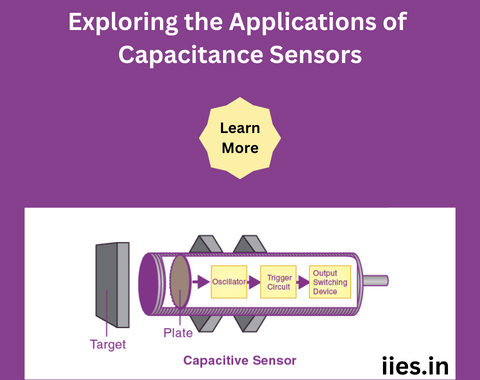
In the realm of modern technology, sensors play a pivotal role in capturing and interpreting data, enabling a wide range of applications across various industries. One such type of sensor that has gained prominence is the capacitance sensor. This article delves into the fascinating world of capacitance sensors, exploring their principles, advancements, and diverse applications.
Capacitance sensors operate based on the principle of capacitance, which is the ability of a system to store an electric charge. In the context of sensors, capacitance is manipulated to detect changes in the environment, leading to the measurement of various physical quantities. The basic construction of a capacitance sensor involves two conductive surfaces separated by a dielectric material.
When an electric potential is applied across the conductive surfaces, a capacitance is formed. The capacitance value is influenced by factors such as the surface area of the conductors, the distance between them, and the properties of the dielectric material. As the distance between the conductive surfaces changes or the dielectric properties are altered, the capacitance value also changes.
Over the years, advancements in material science and electronics have led to the development of sophisticated capacitance sensors with enhanced sensitivity and accuracy. Microfabrication techniques have allowed the creation of miniaturized sensors, making them suitable for integration into compact electronic devices. Additionally, innovations in signal processing and data interpretation have improved the reliability of capacitance sensor measurements.
1. Proximity Sensors:
Capacitance proximity sensors are widely used for detecting the presence or absence of an object without physical contact. These sensors can be found in applications such as touchscreen devices, where they enable touch input without the need for pressure.
2. Level Sensors:
Capacitance level sensors are employed to measure the level of a liquid or granular substance in a container. By placing the sensor in proximity to the material, changes in capacitance indicate variations in the level, providing valuable information in industries like food processing and pharmaceuticals.
3. Pressure Sensors:
Some capacitance sensors are designed to measure pressure variations. As pressure changes the distance between conductive surfaces, the capacitance value adjusts accordingly. This technology finds applications in medical devices, automotive systems, and industrial processes.
4. Humidity Sensors:
Capacitance-based humidity sensors measure the water content in the air by assessing the dielectric properties of the surrounding medium. These sensors are crucial in environmental monitoring, climate control systems, and meteorological applications.
1. Consumer Electronics:
Capacitance sensors are integral components in smartphones, tablets, and other touchscreen devices. The ability to detect touch without physical pressure has revolutionized the way users interact with technology.
2. Automotive Industry:
In automobiles, capacitance sensors are employed in airbag systems, tire pressure monitoring, and fuel level sensing. The non-contact nature of capacitance sensors makes them ideal for applications requiring reliability and durability.
3. Industrial Automation:
Capacitance sensors are widely used in industrial automation for tasks such as object detection, level sensing, and quality control. Their versatility and precision contribute to increased efficiency in manufacturing processes.
4. Healthcare Sector:
Capacitance sensors play a crucial role in medical devices, such as glucose monitors and infusion pumps. Their sensitivity allows for accurate measurements in critical healthcare applications.
5. Environmental Monitoring:
Capacitance sensors are employed in environmental monitoring systems to measure humidity levels, soil moisture, and water content. These sensors contribute valuable data for agricultural and ecological research.
While capacitance sensors offer numerous advantages, they are not without challenges. Factors such as temperature variations and interference from other electronic devices can impact sensor accuracy. Researchers and engineers are continually working to address these challenges and improve sensor performance.
The future of capacitance sensors holds exciting possibilities. Advancements in materials, signal processing algorithms, and machine learning are expected to further enhance the capabilities of capacitance sensors. Integration with Internet of Things (IoT) platforms will enable real-time data collection and remote monitoring, opening up new avenues for applications in smart homes, cities, and industries.
1. Flexible and Stretchable Sensors:
Researchers are exploring the development of flexible and stretchable capacitance sensors, opening up possibilities for applications in wearable technology and electronic skins. These sensors could be integrated into clothing, enabling health monitoring and gesture recognition without compromising comfort.
2. Multi-Touch and 3D Sensing:
Capacitance sensors are advancing beyond basic touch functionality to support multi-touch and 3D sensing capabilities. This evolution is particularly relevant in virtual and augmented reality systems, where precise and intuitive user interactions are crucial for a seamless experience.
3. Energy Harvesting:
Capacitance sensors can be part of energy harvesting systems that convert ambient energy, such as vibrations or temperature differentials, into electrical power. This innovation holds promise for self-powered sensor nodes in remote or inaccessible locations, reducing the need for frequent battery replacements.
4. Biomedical Applications:
In the biomedical field, capacitance sensors are being explored for applications beyond traditional medical devices. Researchers are investigating their use in monitoring physiological parameters, such as hydration levels, and even for detecting specific biomolecules, offering potential breakthroughs in personalized healthcare and diagnostics.
Capacitance sensors have evolved from simple proximity detectors to sophisticated devices with a wide range of applications. Their ability to measure changes in capacitance offers a versatile solution for detecting and quantifying various physical parameters. As technology continues to advance, capacitance sensors are likely to play an increasingly vital role in shaping the landscape of modern electronics, automation, and healthcare.
Indian Institute of Embedded Systems – IIES